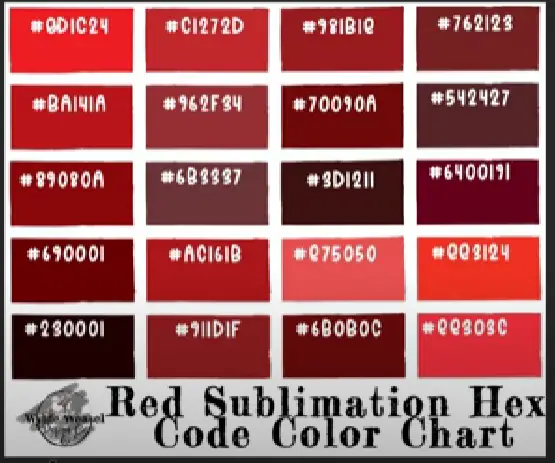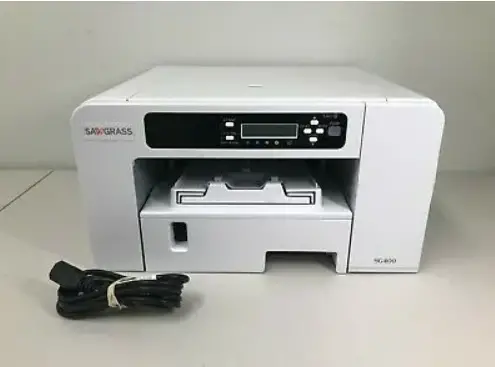What to do if Sublimation Red Is Orange? Sublimation is a complicated procedure and there could be a number of things going wrong in your combination of printing tools. These issues might cause you to get orange instead of red or other red shades than the one chosen.
So, the question is, why your sublimation red is orange?
Your sublimation red is orange either because the shade of chosen red is out of range of the color space you are working on. Or, it could be because your ICC profile has not been updated for sublimation printing. Other than these, improper heat, time, and pressure settings can cause this too.
To find out all the possible causes of this problem and how to solve it, read through the article below.
General Troubleshooting of Not Getting Desired Color While Printing. Sublimation Red Is Orange
There might be a number of reasons why you are getting red instead of orange from sublimation printing. We have a list of basic solutions that you try to do to fix this issue. If the problem is more complicated, however, you need proper guidelines, which are mentioned later in this article.
- If you are using Adobe Photoshop, set the workspace to Adobe RGB 1998 and not sRGB.
- If you have an inkjet printer, make sure to convert it to a sublimation printer before sublimation printing.
- Use the “normal” printer driver which is the standard printer driver and not the “power” printer driver.
- Turn off all color correction settings- “auto color correction”, “brightness”, and “saturation” in printer driver settings.
- Adjust the onscreen colors until the color on the print is close to the desired color.
- Lessen the saturation levels.
- Print in “Relative Colorimetric”.
- Manually clean your printhead. Clean your nozzles.
These solutions can also help you in getting proper black color while printing.
Major Causes for Red to Turn Orange In Sublimation Printing. Sublimation Red Is Orange
If you have tried all of the above-listed fixes and are still getting orange instead of red, there might be more intrinsic issues. Have a look at them below, and their causes and solutions.
Sublimation Red Is Orange. Issue 1: Out of Gamut
There are two modes while working with sublimation printing. The RGB -Red Green Blue mode or CMYK- Cyan Magenta Yellow and Key mode.
If you choose a red shade in Photoshop and a triangle appears saying “Out of gamut”, it typically also means out of range. That particular red shade cannot be reproduced using the range of CMYK color space that is available.
This is common because the colors that we see on the monitor are in RGB mode but the printer works in CMYK mode. The range of colors in RGB is much bigger than that of the CMYK color space. Therefore the sublimation printer will not be able to reproduce the exact same shade of red.
Solution: Make a Color Chart
If you use the color picker to choose a shade of red that is “out of gamut”, you will not get that color. The design software will automatically adjust to the shade available in the color space and print it. This is why you need “ hex codes”.
Hex codes are codes unique to a particular color or shade. If you put in the exact code for a particular red, there is no chance of a mismatch.
So, you can pick out the hex codes for different shades of red and combine them to get a color chart. Print and press them to see what they look like on print, so you know which to pick for your desired color.
Here is a color chart specifically for red shades that might help you out.

Issue 2: Wrong Printer
If you are using a used inkjet printer by converting it to a sublimation printer, you will not get desirable results with color. This is because the conversion from inkjet to sublimation printer is only possible on a completely unused one.
It is also an extremely complicated process and an inkjet printer might not have the right parts needed for sublimation printing.
Solution: Use a Sublimation Printer
The best solution to printer problems is getting a sublimation printer. The color accuracy on a brand-new sublimation printer is much greater than on a converted inkjet printer.

You can try out the sublimation printers listed below. They are popular for their features mentioned in the table.
| Printer Type | Best Feature | Price |
| Sawgrass Virtuoso SG400 | High-quality, detailed images | Check Latest Price |
| Mitsubishi CP-D70DW | High-quality images and high speed of delivery | Check Latest Price |
| EPSON Stylus C88+ | Scratch and water resistant, most price effective | Check Latest Price |
Issue 3: Incorrect Time, Temperature and Pressure Settings
Time and temperature are crucial factors in the sublimation process. During sublimation printing, the ink is turned into a gas by heat. Insufficient heat will not allow all the ink to transform into gas and hence, the coloring will not be accurate.
Similarly, if insufficient time is given to the sublimation process, the ink will not be able to sublime fully. Also, it will not have enough time to bind with the substrate after subliming. Hence, poor coloring will be achieved.
Pressure is important too since it affects the transfer of the ink into the substrate. Too low pressure will result in incomplete transferring and hence wrong coloring.
Solution: Use accurate time and temperature specifications
In the table below we have a set of temperature and time values for you that you should follow while sublimation printing. The values change depending on which material you choose to print on.
| Type of Substrate | Temperature | Time | Pressure |
| Ceramic Mugs | 350-400°F | 150-210 seconds | 40 psi |
| Light/WhitePolyester Fabric | 400°F | 35-40 seconds | 40 psi |
| Mouse Pads (PolyesterFabrics) | 400°F | 45 seconds | 40 psi |
| Plywood | 400°F | 60 seconds | 40 psi |
| Metal/Aluminum(Unisub) | 400°F | 60-80 seconds | 40 psi |
| Metal/Aluminum(Other brands) | 400°F | 60 seconds | 40 psi |
Issue 4: ICC Profile Not Uploaded to Sublimation Printing Specifications
Not updating your ICC profile to sublimation printing specifications can give you the wrong colors upon printing.
This is because it is the ICC profile that sets the gamut of the color space for your printer. It also contributes by mapping the colors from one color space to another, so they remain the same.
Thus, if not uploaded to sublimation specifications, the printer does not make the colors on print according to the colors on the screen.
Solution: Upload ICC Profile
For different combinations of ink and paper and printer, different ICC profiles are suitable. Therefore you should try out a few profiles to see which gives the best results for your case.
Once you have gotten a suitable ICC profile, the next step is to install it on your device. Below are guidelines to follow if you are printing from your desktop.
Your ICC profile will ensure the accuracy of the color that you get by sublimation printing. To install and use the ICC profile for sublimation printing follow the steps below.
Step 1: Download the ICC Profile that suits your printer combination. If it is a zipped file, unzip it.
Step 2: Select “Install Profile” after right-clicking on the file.
Step 3: If you are using Photoshop, select “Print” in the file menu, and then select “Photoshop Manages Colors” in the pop-up. The Color Handling menu will appear where you select the ICC profile of your preference.
You need to properly upload the ICC profile for the software to work properly. the steps for uploading your ICC profile.
Issue 5: Wrong ink
If you are getting red colors as orange, the ink brand you are using might not be the right fit for your printer. The quality of ink varies with the brand as well, and poor quality ink may not sublime fully, so, the colors will be less bright.
Solution: Change to a Different Ink
The Hiipoo water-based sublimation ink is especially known to give the brightest color to the print. Hence, by using this, your red colors will stay red and not fade out. They are compatible with a wide range of printers but particularly with the Epson printer.
Issue 6: Type of Material
Sublimation printing is not suitable for all types of material. In general, polyester or ceramic are the materials on which sublimation printing gives the best results. Polymer material like acrylic fabric can also undergo sublimation printing. Also, You can print on natural and synthetic leather.
However, if you are trying to print on a 100% cotton fabric, sublimation will not work, hence, it is best to use digital printing instead. The color that you get also varies depending on the design that you are trying to print.
Solution: Hacks for printing
You can coat your substrate with a polyester coating since the ink sublimes well into it. This will give you brighter images and better color quality. Using a good quality sublimation paper will also bring significant changes to the colors on the print.
The best sublimation paper, found from a comparison test, is TexPrint Sublimation Paper. Alternatively, you can also use Hiipoo Sublimation Heat Transfer Paper. Both of these are known to give bright colors on print, so your red will not fade to orange, if you use these.
Frequently Asked Questions (FAQs): Sublimation Red Is Orange
Why is my sublimation turning yellow?
The sublimation paper leaving yellow color on substrates like t-shirts is due to the sublimation paper undergoing yellowing. If in the ironing stage of sublimation, too much heat is applied to the sublimation paper, its upper layer will burn. Upon burning, it will become yellow or discolored and subsequently leave this yellowing on where it attaches to.
What Apparel Color Is Best For Sublimation?
The best apparel color or the most inclusive apparel color for sublimation is white. This is because, in the CMYK mode, it is impossible to produce white using the combination of colors available. So, if the apparel is white, it is just left as it is in areas that need to be colored white. But if the apparel is in another color, it is not possible to color it white anyhow.
Do You Peel Transfer Paper Hot or Cold?
For marble and polyester linen, the transfer paper should be peeled while hot. For other substrates, there are no such specifications.
Conclusion: Sublimation red is orange
That is a wrap on all your worries about why sublimation red is orange. We have tried to investigate every possible problem in your printer that could cause this. We hope after trying out the fixes or solutions provided, you no longer have this problem.




